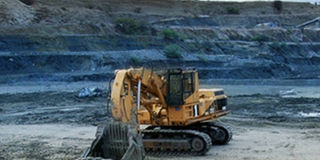Unleashing Tanzania’s mining potential

What you need to know:
- While the current government has rightly highlighted industrialisation as its priority, one should not ignore the potential role that mining can play. Indeed, a large chunk of the foreign exchange income and economic growth over the last decade can be directly attributed to mining. A lot of the public debate on mining has often placed too much focus on absolute corporate tax collections, leaving out the catalytic impact that mining has had on other sectors such as hospitality and transport.
In the current economically turbulent times, Tanzania is an impressive exception. With 7 per cent GDP growth, sustainable levels of both debt and fiscal deficit and the recently well tamed domestic inflation, the economy is poised to maintain its momentum in the medium term. And if the oil markets continue to behave the way they have in the last half year with prices remaining low, Tanzania’s balance of payments will retain its relatively strong solidity.
While the current government has rightly highlighted industrialisation as its priority, one should not ignore the potential role that mining can play. Indeed, a large chunk of the foreign exchange income and economic growth over the last decade can be directly attributed to mining. A lot of the public debate on mining has often placed too much focus on absolute corporate tax collections, leaving out the catalytic impact that mining has had on other sectors such as hospitality and transport.
This mining story is worth dwelling on for a while. The early part of the mining renaissance was characterised by a period of very low gold prices – in particular from the late 90s till around 2004 / 2005 following which there was a steady rise during the time that economists now call the commodity ‘super cycle.’ Over the last decade or so commodity prices went up, with the price increase for many commodities (for example, copper and nickel) fuelled by China’s demand. Mining firms increased production, hoping that demand and the resulting high prices would be sustained.
Though Chinese demand was not a driver for the gold price in the same way as for other minerals, the gold price did also increase significantly over the same period – peaking at $1,900per ounce in 2011. This gold price increase was a boon for Tanzania large gold mines as it ensured the viability of thousands of jobs and an ecosystem for a service industry for firms serving these mines.
The super cycle is unlikely to return. Chinese demand has slowed (China accounts for 70 per cent of the world’s iron demand and 40 per cent of the world’s copper demand), and mining investors are increasingly opting to withhold capital investments in the sector globally.This tough time for mining globally is exemplified by the fact that 40 of the top mining companies globally experienced their first collective loss last year. According to PwC’s 2016 edition of their “Mine” report (www.pwc.com/mining), these top mining firms had impairments of $53 billion, halved their dividends, and have now written off 32 per cent of the capital expenditures since 2010.For Tanzania this downturn has adverse implications – for example, in relation to the viability of the various nickel prospects in the country.
The price of gold is in practice driven by factors different to other commodities. Nevertheless, the same period has seen a significant decrease in the price of gold, which having stood at $1,900 per ounce in late 2011 was at only $1,245 per ounce in April 2015. The impact of this was illustrated by Acacia Mining’s December 2015 announcement of job cuts of 27 per cent of the workforce, beinga response to the need to restore profitability and conserve cash –at that point the share price had declined to 180 pence per share as compared to 575 pence per share when listed in March 2010! Indeed the lowest point for the share price was 98 pence per share in July 2013. More recently the share price has improved with the price in August 2016 briefly getting back to levels of the listing price before then declining again to around 440 pence per share as at mid November 2016. So contrary to perceived anecdotal wisdom, shareholders in Acacia Mining plc have not benefitted from anything like windfall gains. Instead as things currently stand, the share price is “under water” as compared to the price when listed over six years ago.
Naturally, the downward gold price trend has dampened the investor’s appetite but this is not the full story. Because despite this trend other countries have continued to open large scale gold mines - in particular, Burkina Faso has commissioned eight gold mines in the last six years, whereas Tanzania’s last new, large scale gold mine was opened in 2006 despite the clear presence of reserves. This is concerning, especially because a number of gold mines have closed in the recent past or significantly reduced activities (Golden Pride (closed), Tulawaka (now being run at a much smaller scale)), and other mines currently in operation (for example, Buzwagi) have been announced as not having a long mine life.One contrast between Burkina Faso and Tanzania appears to be in the policy environment – in particular, the Fraser Institute 2015 survey of mining companies (https://www.fraserinstitute.org)in its investment attractiveness index ranked Burkina Faso as 2nd out of 20 African mining jurisdictions whereas Tanzania only ranked 13th out of 20 (and 69th out of 109 mining jurisdictions globally).So we do need to take note and address whatever it is that needs to be done to improve our investment attractiveness ranking as we clearly still need inward foreign investment into the sector.
The good news for Tanzania is that despite all this the future for certain minerals is bright. In particular, Tanzania is blessed with a number of minerals found in few locations globally including helium, graphite, niobium and rare earths and it is highly likely that a number of these prospects will move to development. The ‘battery boom’ will drive demand for graphite (carbon) used as anode material in lithium ion batteries – with such demand estimated to increase by over 200 per cent in the next four years as global cell production surges on the back of maturing pure electric vehicle demand and the inception of the utility storage market. With the change in energy dynamics, increased investment in renewable technologies, minerals like graphite and rare earths look like the next big frontier. The challenge will be attracting enough capital so that such wealth is exploited not only profitably, but also in a way that buttresses the economic gains we have made so far.
One thing to note is that there needs to be an appreciation for the contribution that mining plays and has played in the last decade. Again, according to the PwC “Mine” report, miners are still making significant contributions to governments despite their lack of profits. One of the blind spots of the general discussion on mining contribution is excessive focus on profit based taxes, and insufficient focus on other taxes and contributions generated by the industry – with the consequence of ranked up rhetoric on whether mining firms are paying their fair share. If the last decade has taught us anything is that mining is a very risky industry, often requiring huge capital investments upfront. The contribution of the industry therefore needs to be viewed in that context, together with the wider catalytic impact that the mine’s economic activity creates. Not least as a generator of foreign exchange(According to the Bank of Tanzania, mining accounted for 43 per cent of the total exports in 2013)!
Tanzania is incredibly blessed. The country has all sorts of minerals, from gold to graphite, from tin to tanzanite, graphite and rare earths. Tanzania’s Vision 2025 assumes a 10 per cent contribution to GDP by mining. Unlocking that wealth for economic transformation will however require significant infusions of capital into the sector. Certainly, private capital is going to have to be attracted if we are to unleash that potential. It is going to be important for us as a country, and policy makers specifically, to fully appreciate the role and impact of the sector and try to get more investment into the country. By the way, mining could help more immediately diversify and significantly increase the country’s exports (and create an economic buffer in times of economic challenges) as we focus on the more medium term prospect of the gas economy and large scale industrialisation.
David Tarimo ([email protected]), Country Senior Partner – PwC Tanzania and Samwel Ndandala ([email protected]), Tax Manager – International Tax Services, PwC Tanzania. The views expressed do not necessarily represent those of PwC. For updates from PwC on tax and other matters, follow @pwc_tz.



